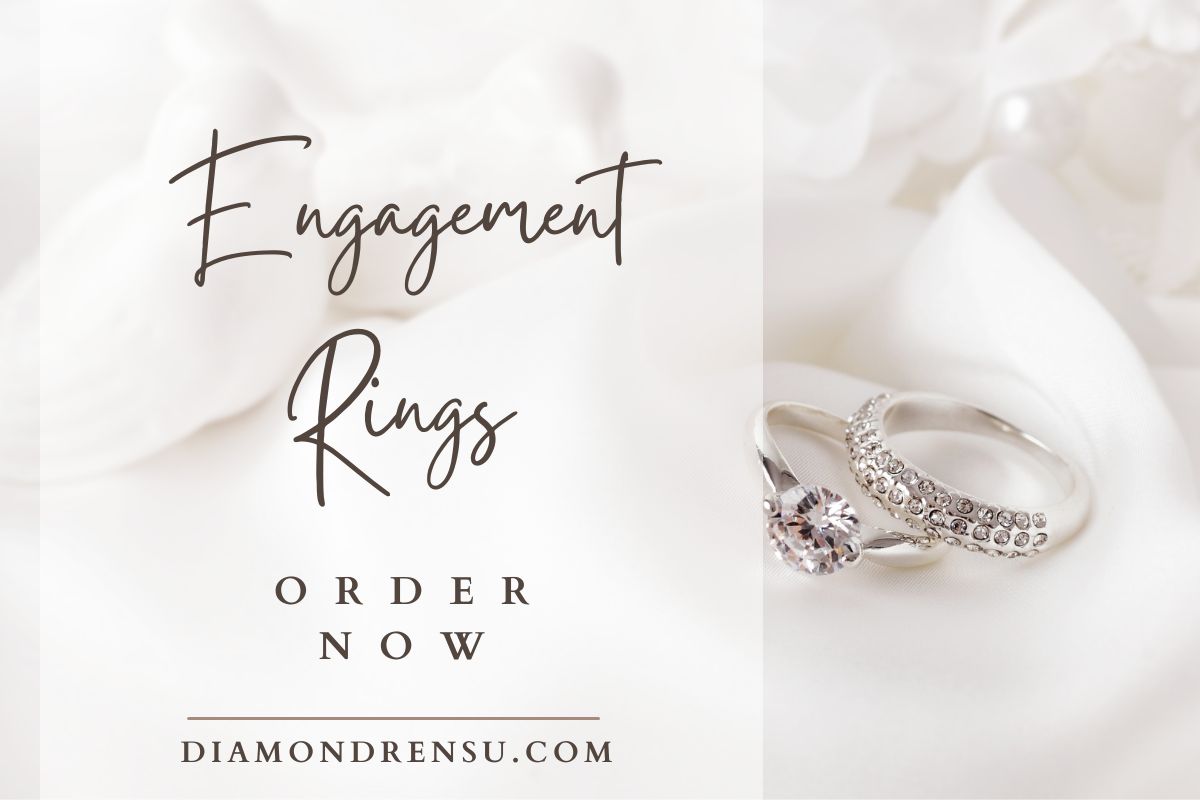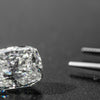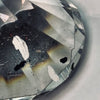
Feather Inclusion in Diamonds: Clarity Characteristics and Value Impact
In the fascinating world of diamonds, the clarity of these precious stones is often assessed by their inclusions, which are natural characteristics found within them. One such inclusion is known as a feather, which is essentially a small crack within the diamond. Observing a feather inclusion often requires magnification, but its appearance can resemble a feather—hence the name. These inclusions are particularly noteworthy because they can affect both the aesthetic appeal and the structural integrity of the diamond.
We understand that clarity is a critical factor when selecting a diamond and feather inclusions merit special attention. When viewed from a certain angle, feathers could appear white or dark, and although some might not compromise the diamond's durability, others, especially larger or more numerous ones, could pose a risk. Their impact on the diamond largely depends on their size, location, and orientation within the crystal structure. The presence of feather inclusions near the girdle or alongside other types of inclusions can weaken a diamond, making it more susceptible to damage if it were to be struck in those areas.
It is important for us to consider the size and position of feather inclusions when assessing a diamond's quality. Not all feathers are visible to the naked eye and do not necessarily detract from a diamond's beauty. However, their presence is a crucial factor in defining the clarity grade of the diamond and consequently, its overall value. As with all diamonds, each stone with a feather inclusion is unique and requires individual evaluation to determine how it may impact both its appeal and durability.
Understanding Feather Inclusions in Diamonds
When we discuss diamond quality, inclusions play a critical role, and among them, feather inclusions are both common and impactful on a diamond's overall characteristics.
Definition and Characteristics of Feather Inclusions
Feather inclusions are internal features resembling fractures or cracks within the diamond. Key characteristics of feather inclusions include:
- Nature: Internal fractures mimicking the look of feathers.
- Impact on Clarity: Can affect the stone's clarity, particularly if large or centrally located.
- Effect on Durability: Potentially weaken the diamond, especially if located at the edges or near other inclusions.
The Formation of Feather Inclusions
Feather inclusions are products of extreme pressure and stress conditions during the diamond formation process deep within the Earth. These stresses can cause:
- Internal Strains: Results in fractures as carbon atoms are misaligned.
- Cracks: As pressure releases during the trip to the surface, existing fractures can extend, forming feathers.
Visual Appearance of Feather Inclusions
The visibility of a feather inclusion can range from noticeable with the naked eye to detectable only under 10x magnification. The appearance often relies on:
- Size and Position: Larger and more centrally located feathers are more visible.
- Coloration: Feathers might appear white or dark, influencing their visibility.
- Eye-Clean Grade: Some diamonds with small feathers can still be considered "eye-clean," meaning the inclusion is not visible to the unaided eye.
The Impact of Feather Inclusions on Diamond Quality
Visibility of Feather Inclusions 🔍
Visible feather inclusions can affect diamond clarity and diminish brilliance.
Brilliance 💎
Feather inclusions may scatter light, affecting the diamond's sparkle and brilliance.
Durability 🛡️
Feather inclusions may weaken the diamond's structure, reducing its durability and increasing the risk of damage.
Value 💰
Diamonds with fewer visible feather inclusions are considered more valuable.
Impact on Certification 📜
Feather inclusions are assessed during diamond grading, affecting the stone's clarity grade.
Considerations for Purchase 🤔
Consider feather inclusions when buying diamonds to ensure satisfaction with the purchase.
We understand that when selecting a diamond, its internal characteristics significantly influence both its aesthetics and its longevity. Feather inclusions are internal features of critical interest as they can affect clarity, durability, and the overall beauty of the stone.
Diamond Clarity and Feather Inclusions
Feather inclusions are cracks within a diamond that, depending on their size and location, can impact the clarity grade significantly. Diamonds are graded from Flawless to Included, and feathers are considered clarity characteristics that can alter a diamond's grade. They may appear as wispy lines within the stone and depending on their visibility, they can lower the clarity grade of the diamond, sometimes quite substantially.
How Feather Inclusions Affect Durability and Structure
The presence of a feather inclusion can introduce a durability risk to a diamond. Depending on their size and position, they can make the stone more susceptible to chipping or breaking, especially if located at the edges or points of the diamond. While not all feathers pose a significant durability issue, diamond chipping is more likely if the feather reaches the diamond's surface.
Feather Inclusions and Diamond Beauty
A diamond's beauty is often gauged by its sparkle, brilliance, and fire. While small or strategically located feathers may not detract from a diamond's aesthetic, noticeable feathers can impact the stone's light performance. The sparkle could be diminished if the feathers interfere with the path of light through the diamond, affecting the overall beauty and aesthetic appeal of the stone.
Assessing Feather Inclusions

When considering feather inclusions in diamonds, we must examine their impact on clarity grading, discernibility to the naked eye, and the potential risk they pose to diamond durability.
Diamond Clarity Grading and Feather Inclusions
The Gemological Institute of America (GIA) and the American Gem Society (AGS) employ a clarity scale to grade diamonds. Feather inclusions affect a diamond's clarity grade, which ranges from 'Flawless' to 'Included'. The appearance, size, and location of these feather inclusions within the diamond are scrutinizingly assessed to determine the appropriate clarity grade. A diamond with smaller or strategically located feathers may receive a higher clarity grade, whereas prominent feathers may result in lower grading.
- Flawless (FL): No inclusions or blemishes visible under 10x magnification
- Internally Flawless (IF): No inclusions and only insignificant surface blemishes visible under 10x magnification
- Very, Very Slightly Included (VVS1 and VVS2): Inclusions so slight they are difficult for a skilled grader to see under 10x magnification
- Very Slightly Included (VS1 and VS2): Inclusions are observed with effort under 10x magnification but can be characterized as minor
- Slightly Included (SI1 and SI2): Inclusions are noticeable to a skilled grader under 10x magnification
- Included (I1, I2, and I3): Inclusions are obvious under 10x magnification and may affect transparency and brilliance
Visibility: Eye-Clean and Non-Eye-Clean Diamonds
When assessing feather inclusions, the term "eye-clean" refers to diamonds in which inclusions, such as feathers, are not visible to the naked eye. Eye-clean status significantly influences a diamond's aesthetic appeal. However, this term is subjective because it depends on the observer's vision and the viewing conditions. Diamonds may exhibit feather inclusions that are invisible to the naked eye but can still affect the clarity grade. In contrast, non-eye-clean diamonds have inclusions that are visible without magnification, potentially impacting the perceived clarity and beauty of the diamond.
Evaluating the Risk Factor of Feather Inclusions
The durability risk posed by feather inclusions can vary greatly. Feathers that reach the surface pose a higher risk of chipping, especially if located at the girdle or in corners of shapes like princess or marquise. Feather inclusions located deep within the diamond or in less vulnerable areas may pose less of a risk. It's critical to consider the feather's orientation, size, and position to evaluate the potential impact on diamond durability. Large feathers, or those that extend through a significant portion of the diamond, can diminish both structural integrity and value.
- Low Risk: Small, contained feathers away from the diamond's surface
- Moderate Risk: Larger feathers or those near the girdle but not reaching the surface
- High Risk: Feathers that reach the surface or are located at points of potential impact
Diamond Grading Reports and Feather Inclusions

When we examine diamond grading reports, our focus often narrows down to clarity grades and the inclusions that affect them. Feather inclusions are a primary concern due to their impact on a diamond’s appearance and structure. We'll guide you through understanding the clarity plots on grading reports, the role of GIA and AGS in clarity grading, and the terminology used to describe these feather inclusions.
Interpreting Clarity Plots on Diamond Grading Reports
A diamond grading report often includes a clarity plot—a detailed diagram that maps out the exact locations and types of inclusions within a diamond. When identifying feather inclusions on these plots, look for symbols resembling diagonal squiggles. The size, number, and position of these marks have substantial significance; they often determine the visibility and potential impact of the feather inclusions on the diamond's overall clarity. A single, large feather inclusion that reaches the surface could potentially pose more of a durability risk than multiple smaller enclosed feathers.
Role of GIA and AGS in Diamond Clarity Grading
The GIA (Gemological Institute of America) and the AGS (American Gem Society) are prestigious institutions in the domain of gemology, setting the standards for diamond grading practices worldwide. These organizations utilize meticulous procedures to assess diamond clarity. In their grading reports, they explicitly note feather inclusions. The presence and significance of feathers influence the assigned clarity grade ranging from Flawless (FL) to Included (I). These standards ensure an unbiased quality assessment and help us make informed purchasing decisions.
Understanding the Grading Report Terminology
Understanding clarity-related terminology in grading reports is crucial. Terms like "feather," "included," and specific clarity grades such as VS1 (Very Slightly Included 1) or SI2 (Slightly Included 2) directly correlate to the type and severity of inclusions. For feathers particularly, the terminology in the report will indicate if these fractures are surface-reaching—a trait which may affect the diamond's stability—or if they're enclosed, posing less risk. Moreover, the report may specify the feather’s appearance, for example, noting if it is white and feathery or has a more pronounced color.
Purchasing Diamonds with Feather Inclusions

When considering the purchase of diamonds, it's crucial to understand how feather inclusions can affect the stone's clarity, value, and overall beauty. We will guide you through making informed decisions, assess the impact of such inclusions on a diamond's value, and discuss the role of online retailers like James Allen and Blue Nile in your purchasing process.
Making Informed Purchasing Decisions
When we contemplate purchasing diamonds with feather inclusions, it's essential to use tools like a jeweler's loupe. This enables us to examine the extent and placement of the inclusions at high magnification, allowing us to determine whether they are visible to the naked eye. We should also consider the size and location of the feather inclusions; those located on the periphery may have less impact than central ones.
The Effect of Feather Inclusions on Diamond Value
Feather inclusions influence a diamond's clarity grade and, consequently, its value. Diamonds with minor feather inclusions that are not visible to the naked eye usually retain their aesthetic appeal and are often more affordable than flawless stones. However, larger, more noticeable inclusions can reduce the stone's value. We need to evaluate if the price aligns with the inclusion's impact on the stone's overall quality.
Online Diamond Retailers and Feather Inclusions
Online diamond retailers like James Allen and Blue Nile offer high-resolution imagery and 360-degree videos for customers to scrutinize potential feather inclusions. By providing real-time magnification views, these platforms help us assess whether a feather inclusion poses durability risks or compromises the diamond's integrity. This transparency is vital in facilitating confident online purchases.
Also Read
Frequently Asked Questions
In this section, we answer common questions about feather inclusions in diamonds, helping you understand their impact on value, clarity, and more.
How does a feather inclusion affect a diamond's value?
Feather inclusions can lower the value of a diamond, especially if they are large or prominent. However, minor feathers not visible to the naked eye usually do not significantly impact the diamond's value.
Can the presence of a feather inclusion impact the clarity grade of a diamond?
Yes, the presence of a feather inclusion can affect a diamond's clarity grade. The size, number, and location of these inclusions factor into determining the grade assigned by gemological institutes.
Is it possible for a feather inclusion to cause durability issues in a diamond?
A feather inclusion can pose durability risks, particularly if it is near the surface or extensive, as it can increase the likelihood of the diamond chipping or cracking.
What are the visual characteristics of feather inclusions in diamonds?
Feather inclusions can appear as white or slightly colored lines or cracks within the diamond. Their visibility can vary based on the size and angle of the inclusion.
How are feather inclusions detected and graded by gemological institutions?
Gemological institutions use magnification and expert evaluation to detect feather inclusions. These are then graded based on their size, location, and potential impact on the diamond's clarity and integrity.
What is the difference between a feather inclusion in a diamond and other types of inclusions?
Feather inclusions are cracks within the diamond, while other types of inclusions can be internal or external mineral deposits, growth features, or other structural irregularities that do not necessarily break the diamond's lattice.
Checkout some of our top collections:
Leave a comment
Please note, comments must be approved before they are published.









